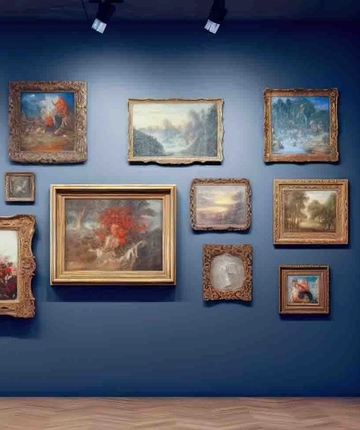TOWN SQUARE


Project Tarsus: A Model for Co-creation in Digital Art
I entered 2023 with a personal goal to put into practice the concept I describe in my pinned tweet of “co-creation” - recognizing that artist and collector play different roles in this Digital Art marketplace and together they give meaning and purpose to a piece of work.
This concept forms the basis of a new model for the creation of Digital Art where Patrons and Artists collaborate to launch projects that result in amazing Art that will be immutably memorialized on chain in the service of a higher purpose.
The first Project is called Project Tarsus and involves a commission I’ve made with the exceptional aerial photographer @Beh0ldingEye Paul Seibert whose work I’ve collected and who I consider a friend.
This project involves Paul photographing the area where I grew up in New Jersey from the sky with a specific focus on my local Church, St. Paul’s, which has been my family's place of Baptisms, Communions, Weddings and Funerals since the late 1800s.
It was by chance that when I told Paul that I was thinking about this project, he went into his archives and found an older shot from his past trips that is almost a perfect match for what we hope to do!
The steeple is that of St. Paul’s in the shadow of the NYC skyline. We’re producing prints of this image, and several others that include the steeple in the frame, to sell at the event with the proceeds going to the Church.
On the weekend of June 23, 2023, Paul will get up in a helicopter and capture some new images specifically for Project Tarsus. During this weekend the Church is also hosting a Festival so we hope to capture colors and lights from the Festival as part of the aerial shot.
I’ve committed to paying Paul a fee for a 1:1 of the project, and have agreed to cover the costs of his trip to the NYC area. I’ve also paid him a one-time fee for the images above for the right to sell them as prints.
In return, Paul generously offered the prints at a reduced price to his typical fee and has agreed to donate a number of the images that are not ultimately minted as the 1:1 to be available for sale as part of a small collection with proceeds going to the Church. Royalties will be set to benefit the Artist for any secondary market activity.
This is an example of co-creation that is a win for me, for Paul and hopefully for the Church.
Funny thing is I don’t consider myself a devout and practicing Catholic. I tell people I’m a “recovering Catholic” and have grown away from the teachings of the Church. But, I have strong interest in the convergence of Art + Symbolism + the Human Experience. Making Project Tarsus’ focus on a 160 yr old church a compelling project.
The convergence of Art + Symbolism + the Human Experience is especially relevant today given the dramatic shifts toward a more digital age. One path this shift takes us is a more isolated future. Another is a more connected community.
I’m in favor of the more connected community. So a good jumping off point for me at least in the Projects I choose to pursue will be those that take the lessons of the past and build on them for the future.
And over the course of human history the best example of the convergence between Art + Symbolism + the Human Experience has centered around World Religions, the historic source of our common stories, myths, beliefs and memes.
This is not unique to Western civilization.
Ancient Egyptian civilization: Art was heavily influenced by their religious beliefs. Their understanding of the afterlife, for example, is depicted in the elaborate wall paintings found in tombs. The well-known Book of the Dead is a collection of spells and images that guided the dead through the afterlife.
Ancient Egyptian wooden stela depicting Lady Djedkhonsuiwesankh giving offerings of food, drink, and flowers to Re-Horakhty (c. 950–700 BC); Photograph by Oriental Institute, the University of Chicago; painter unknown, Public domain, via Wikimedia Commons
Mesopotamian civilization: Like ancient Egypt, religion played a significant role in their art customs. Many of their works were devoted to their gods, with intricate reliefs and statues found in temples and ziggurats. The Epic of Gilgamesh, one of the oldest known pieces of literature, includes many spiritual and religious themes.
MESOPOTAMIAN TEMPLES OR ZIGGURATS
Chinese civilization: Art in ancient China was deeply tied to Confucianism, Taoism, and Buddhism. Scroll paintings, pottery, jade carvings, and architecture often reflect these spiritual beliefs. The Forbidden City in Beijing, for example, is filled with symbolism derived from Chinese cosmology and numerology.
Bodhisattva Avalokiteshvara in "Water Moon" Form (Shuiyue Guanyin) 11th century. China. Liao dynasty (907–1125). Wood (willow) with traces of pigment; multiple-woodblock construction. H. 46 1/2 in. (118.1 cm); W. 37 1/2 in. (95.3 cm); D. 28 in. (71.1 cm). The Metropolitan Museum of Art, New York, Fletcher Fund, 1928 (28.56)
Indian civilization: Hinduism, Buddhism, and Jainism have greatly influenced the art of the Indian subcontinent. Temples and sculptures representing deities and religious narratives are common. The intricate carvings in the Ajanta and Ellora Caves or the massive temple complexes of Khajuraho and Hampi provide great examples.
Painting of Padmapani. Cave 1, Ajanta Caves, Maharashtra, India
Mesoamerican civilizations: The Mayans, Aztecs, and Incas incorporated their religious beliefs into their art extensively. From the monumental pyramids dedicated to their gods to the detailed ceramics and textiles depicting their cosmology and rituals, their spiritual beliefs were central.
Head of the Aztec Moon goddess Coyolxauhqui. From Tenochtitlan, carved during the reign of Ahuitzotl, 1486-1502 CE. Green diorite. (Museum of Anthropology, Mexico City)
African civilizations: Many African cultures have a long history of integrating their religious beliefs into their artwork. Masks, sculptures, and textiles often represented deities, ancestors, or spiritual concepts.
Pair of Diviner’s Figures, 19th–mid-20th century (Baule peoples, Côte d’Ivoire), wood, pigment, beads and iron, 55.4 x 10.2 x 10.5 cm (The Metropolitan Museum of Art; photo: Steven Zucker, CC BY-NC-SA 2.0)
Western civilization: While I’m most familiar with Western traditions, it's clear to anyone who has toured Europe the role that Art has played in the cultural development of Europe over millennia across all art forms.
The Transfiguration, Raphael, 1516-20, Oil tempura on wood, Piancoteca Vaticana, Vatican City
In 1999, Pope John Paul II wrote a letter to Artists that reads in part: “Obedient to their [Artists] inspiration in creating works both worthwhile and beautiful, they not only enrich the cultural heritage of each nation and of all humanity, but they also render an exceptional social service in favor of the common good.”
The letter in its entirety is worth a read that describes the role of Art in advancement of human’s desire to get closer to the divine.
Hopefully, Project Tarsus is the first of several co-creation efforts where I join with an Artist in the service of some higher purpose to bend the arc of this digital shift to one that brings us closer together.
https://twitter.com/FrankieDTankie/status/1595136107762839552?s=20

3 Myths about Web3
Web3 is the decentralized web, a new way of using the internet that puts artists in control of their data and digital assets. It's a powerful tool for artists, allowing them to create, store, and monetize their work without relying on centralized platforms or third-party services. For example, when you share to Instagram, the app takes a copy of your image and controls it. They also have legal rights to use your image without paying you. Instagram, Facebook, most social media apps all make a LOT of money off of the content that people upload to them for free. Many artists don't find it easy to make money off Instagram or Facebook.
Unfortunately, there are still a lot of misconceptions about Web3. Even though there are a lot of things that aren't perfect yet, we'll clear up the top three misunderstandings so you can make an informed decision about whether Web3 is right for you.
Misconception 1: It's too late to join the NFT craze.
As an artist, have you ever felt like you've missed the boat on the high priced art sales and don't want to feel like you are starting over on another social media platform? We get it; many artists are hesitant to dive into the NFT world, discouraged by low sales, big learning curve, lots of scams, and high transaction fees in the crypto market. But let me share a secret with you: at MeLlamoArt, we see immense long-term value in NFTs for artists.
Like Facebook and Instagram, Twitter and NFTs is a tool that can help artists diversify their income streams, make greater connections, and bring one's artwork in front of new people.
This makes us bring up the wise words of Vincent van Gogh: "Great things are done by a series of small things brought together."
Small steps forward. You don't need to become a crypto blockchain expert overnight. Or take a 3 month long course on marketing and funnels. For every artist they will have to create their own path suited for their situations and goals.
MeLlamoArt's Founder, Matt, likes to say, "There is no one strategy for everyone, but everyone needs a strategy." With an effective marketing strategy and the right approach, taking the leap into the NFT world now can be the catalyst that propels you to a place you never thought possible with your art.
Misconception 2: You need a large social media following to get into web3 and sell art.
We are here to tell you, it's not about the number of followers you have; it's about the quality and engagement of your community.
Remember the story of the tortoise and the hare? Slow and steady progress can lead to big wins, and that's especially true when building a community in Web3. It may take time, but investing in genuine connections is what truly matters.
Think about this: how many artists do you know who have created a successful career without millions of followers? The key lies in the quality and value you bring to the table and the relationships you nurture. Digital art sales are on the rise, and you can make a significant impact even without a massive social media presence.
As the great Maya Angelou once said, "People will forget what you said, people will forget what you did, but people will never forget how you made them feel." So, why not focus on engaging with your community and creating authentic connections? For many, the human connections they have made in web3 have led to deeper relations to other art enthusiasts and even to some exciting and new opportunities with their art that they never got after years on Instagram.
Success in Web3 isn't just about the numbers. It's about cultivating a loyal, engaged community that resonates with your work and your message. We encourage artists who are interested to embrace the learning curve. A journey of a thousand miles begins with a single step – and that first step could be the beginning of something extraordinary.
Misconception 3: You need special skills or knowledge
It's true that having some technical knowledge can be helpful when working with Web3 technologies like blockchain and smart contracts – but it's not essential! There are plenty of tools out there designed specifically for non-technical users who want to take advantage of what the decentralized web has to offer. For example, Manifold makes it easy for anyone – regardless of their technical background – to publish art securely on the blockchain without needing any coding experience whatsoever!
Web3 offers tremendous opportunities for artists who want more control over their work and greater freedom from centralized platforms and third-party services – but only if they know how to take advantage of it. By debunking some common misconceptions about Web3 technology, we hope this article has given you a better understanding of how it works and why it could be beneficial for your creative career going forward.

